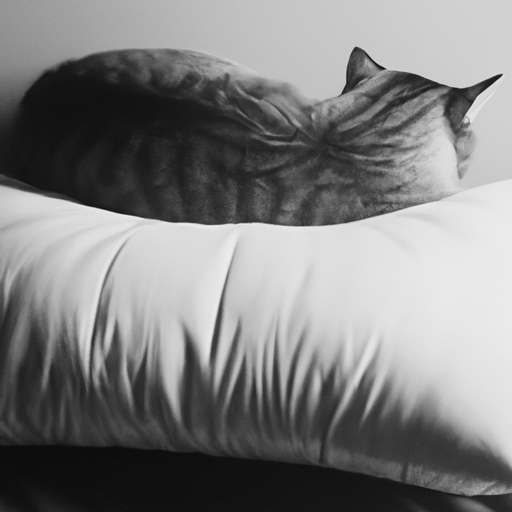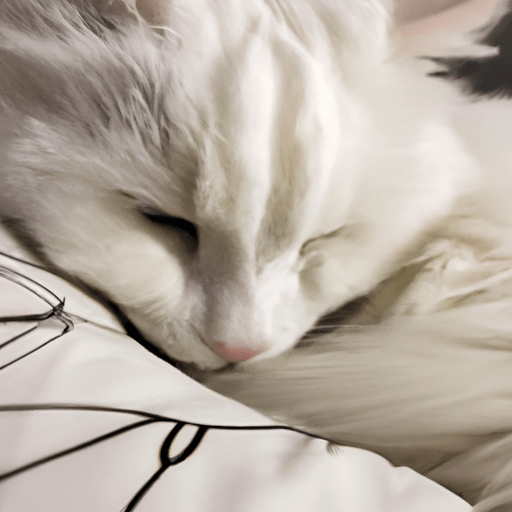Have you ever wondered why your cat loves sleeping on your pillow? It’s a common behavior that many cat owners have observed, but the reasons behind it may not be immediately clear. In this article, we will explore the fascinating behavior of cats sleeping on pillows and delve into the possible explanations for this cozy habit. From their need for warmth and comfort to their instinctual desire to mark their territory, we will uncover the intriguing motivations behind your feline friend’s choice of nap spot. So, grab a cup of tea and get ready to unravel the mysteries of your cat’s sleeping preferences!

Why Cats Choose Specific Sleeping Locations
Understanding Cat Behavior
Cats have been known to display peculiar behaviors, and their sleeping patterns are no exception. Understanding why cats choose specific sleeping locations can give us valuable insight into their behavior. Cats are creatures of habit and prefer to sleep in familiar and comfortable spots. By understanding the factors that influence their choice of sleeping locations, we can gain a deeper understanding of our feline friends.
Factors Influencing Cat Sleeping Spots
Several factors influence a cat’s choice of sleeping spots. One significant factor is the cat’s need for safety and security. Cats are instinctively drawn to sleeping in elevated positions, such as on top of pillows, as it gives them a vantage point to monitor their surroundings and escape potential threats. Additionally, cats have a strong preference for warm and soft surfaces, making pillows an attractive sleeping spot.
Significance of Higher Ground
The preference for higher ground is deeply rooted in a cat’s primal instincts. In the wild, being elevated provides cats with a sense of security as it allows them to observe their surroundings without being easily spotted or ambushed. By sleeping on pillows, cats mimic this behavior, even in the safe confines of our homes. Sleeping on pillows not only satisfies their need for security but also provides them with a comfortable and warm surface to rest.
Understanding the Pillow Phase in Cats
Meaning of Pillow Phase
Cat owners may have noticed their furry friends exhibiting a behavior commonly known as the “Pillow Phase.” The Pillow Phase refers to the act of cats kneading and pawing at pillows, blankets, or any soft surface before settling down to sleep. This behavior is observed in cats of all ages and is often accompanied by purring and contentment.
Why It Happens
The Pillow Phase is a remnant of a cat’s kittenhood. When kittens nurse, they instinctively knead their mother’s belly to stimulate milk flow. This behavior is comforting to the kittens and becomes ingrained in their system. As cats grow older, they continue to engage in this behavior as a way to self-soothe and find comfort before sleeping.
Duration of the Pillow Phase
The duration of the Pillow Phase varies among cats. Some cats may engage in kneading and pawing for a few minutes, while others may continue the behavior for a more extended period. It is essential to allow cats to complete their Pillow Phase, as it helps them relax and prepare for a restful sleep. Interrupting this process may lead to anxiety or restlessness.
Cats’ Attraction to Human Scents
Peculiar Cat Behavior and Human Scents
It is not uncommon for cats to show an affinity for their owners’ scents, including their pillows. This affinity stems from a combination of factors, including the cats’ acute sense of smell and their close bonds with their human companions. Many cat owners have experienced their feline friends curling up on their pillows, often with a look of contentment on their faces.
Cats’ Attuned Sense of Smell
Cats have a highly developed sense of smell, which is far superior to that of humans. They possess over 200 million odor-sensitive cells in their noses, allowing them to detect even the faintest of scents. This heightened sense of smell enables them to recognize their owner’s scent, often finding solace and comfort in the familiar smell.
Long-lasting Comfort and Security in Human Scents
Cat’s attraction to human scents, particularly on pillows, is rooted in the bond they share with their owners. The scent of their beloved human provides a sense of security and familiarity, creating a tranquil environment for them to rest. Sleeping on pillows that carry the scent of their owners allows cats to feel close to them even when they are not physically present, providing them with long-lasting comfort.
Cat’s Affection Towards their Owners
Demonstrations of Feline Affection
Cats are known for their aloof nature, but they also have a deep capacity for affection towards their owners. This affection can manifest in various ways, including sleeping on their owner’s pillows. By choosing to sleep on pillows, cats demonstrate their closeness to their owners and their desire to be near them.
Bonding with the Owner
Sleeping on pillows can be seen as a bonding behavior between cats and their owners. When cats choose to sleep on their owner’s pillows, they are actively seeking proximity and physical contact. This behavior strengthens the bond between cats and their owners, creating a sense of trust and security.
Trust and Comfort Around Owners
Cats are naturally cautious animals and are constantly assessing their environment for potential threats. By choosing to sleep on their owner’s pillows, cats display a high level of trust and comfort around their owners. They feel safe enough to let their guard down and enter a vulnerable state of deep sleep.

Sleeping Patterns of Cats
Circadian Rhythms in Cats
Just like humans, cats have distinct sleeping patterns governed by their circadian rhythms. Cats are crepuscular creatures, meaning they are most active during dawn and dusk. This natural behavior has its roots in their ancestors, who were adept at hunting during these low-light periods. Understanding these inherent patterns can give us insight into why cats sleep at certain times and in specific locations.
Deep Sleep and REM Sleep in Cats
Cats experience two main stages of sleep: deep sleep and rapid eye movement (REM) sleep. Deep sleep is characterized by complete relaxation, slowed heart rate, and reduced responsiveness to external stimuli. REM sleep, on the other hand, is associated with dreaming and increased brain activity. These sleep stages are vital for cats’ overall well-being, as they promote physical and mental restoration.
Importance of Undisturbed Cat Sleep
Cats require uninterrupted sleep to meet their sleep needs fully. Disturbing their sleep can lead to irritability, restlessness, and even health issues. By understanding their sleeping patterns and providing them with a quiet and comfortable environment, cat owners can ensure their feline companions enjoy quality sleep, thus promoting their overall health and happiness.
Safety and Discomfort: Insights for Cat Owners
Potential Risks of Cats Sleeping on Pillows
While cats sleeping on pillows may be adorable, it is essential for cat owners to be mindful of potential risks associated with this behavior. Pillows can pose choking hazards if a cat’s head becomes trapped between the pillow and any surrounding fabric. Additionally, snuggling with cats on pillows can increase the risk of allergies and asthma in individuals with sensitivities to pet dander.
Ensuring Safety during Co-sleeping
For those who enjoy co-sleeping with their feline companions, it is crucial to establish safe sleeping arrangements. Providing cats with their designated beds or blankets within close proximity to the owner’s pillow can minimize potential hazards. Regularly checking pillows and bedding for any signs of damage or wear can also help prevent accidents.
Recognizing Signs of Discomfort and Stress in Cats
It is essential for cat owners to be attentive to their feline friends’ behavior and recognize signs of discomfort and stress. If a cat shows signs of restlessness, agitation, or avoids sleeping on the pillow, it may indicate that they are experiencing discomfort. In such cases, it is necessary to investigate the underlying cause and make adjustments to ensure the cat’s well-being.

Introduction to Felines and Territory
Territory in the Feline World
Cats are territorial creatures and have an innate need to establish and maintain their territory. This territorial behavior stems from their wild ancestors’ need to secure resources like food and shelter. While domesticated cats may not require the same level of territorial defense, they still exhibit territorial instincts, which can influence their choice of sleeping locations.
Marking Territory: A Primal Instinct
Cats mark their territory through various means, including scent marking. By rubbing against objects or scratching surfaces, cats release pheromones that serve as territory markers. Pillows, being soft and absorbent, can readily absorb a cat’s scent, making them ideal for territorial marking.
Pillows as Marked Territory: Possibility?
It is possible that cats choose to sleep on pillows as a way to establish their territory. By marking a frequently used pillow with their scent, cats send a clear message to other animals, indicating that the pillow is claimed territory. This behavior may also be motivated by a desire to establish their presence and dominance within the household.
Comfort and Heat Seeking Tendencies in Cats
Understanding Warmth Preferences in Cats
Cats are known for their love of warmth, and their choice of sleeping locations reflects this preference. Pillows, being soft, retain heat well, making them an attractive spot for cats to curl up and enjoy a cozy nap. The warmth provided by pillows can help regulate a cat’s body temperature and provide them with a sense of comfort.
Reasoning behind Cats Seeking Soft Surfaces
Cats have delicate bodies and often seek soft surfaces for their sleeping needs. Pillows offer the perfect combination of softness and support, providing cats with a comfortable and cozy place to rest. The pliable material of pillows conforms to a cat’s body, allowing them to find their ideal sleeping position.
Does Temperature Affect Where Cats Sleep?
Temperature plays a significant role in a cat’s choice of sleeping location. Cats are sensitive to changes in temperature and will gravitate towards warmer spots during colder seasons and cooler spots during hotter periods. The insulating properties of pillows can provide cats with the desired level of warmth or coolness, depending on the ambient temperature.
Cats Sleeping on Pillows: A Sign of Illness?
Observing Changes in Sleep Patterns
Changes in a cat’s sleep patterns can be indicative of underlying health issues. While sleeping on pillows itself is not necessarily a sign of illness, alterations in a cat’s routines or preferences should be closely monitored. If a cat’s sleeping habits drastically change, it is essential to keep a keen eye for other symptoms and consult a veterinarian if necessary.
Recognizing Signs of Illness from Sleep Habits
Signs of illness can manifest in a cat’s sleep patterns. Excessive sleeping, restlessness, jittery movements, or difficulty settling down can be indicators of underlying health problems. Abrupt changes, such as avoiding pillows altogether, may also be a cause for concern. Regular observation and communication with a veterinarian can help identify and address any potential health issues.
Ensuring Regular Veterinary Checkups
Regular veterinary checkups are essential to monitor a cat’s overall health and well-being. During these visits, veterinarians can assess a cat’s sleep patterns, offer advice on potential concerns, and recommend appropriate measures to support a cat’s sleep habits. Open communication and proactive care can help ensure that any health issues are addressed promptly.
Alternative Sleeping Arrangements for Cats
Decoding Cat Beds: Types and Preferences
Providing cats with their designated sleeping spaces can help satisfy their natural need for comfort and security. Cat beds come in various shapes, sizes, and materials, catering to different feline preferences. From enclosed caves to plush cushions, the range of cat beds available ensures that owners can find an option that suits their cat’s individual needs.
Choosing the Right Bedding for your Cat
When selecting bedding for cats, it is crucial to consider factors such as comfort, ease of cleaning, and durability. Cats have varying preferences when it comes to the texture and thickness of bedding material, so it may require some trial and error to find the ideal option. Additionally, ensuring that the bedding is hypoallergenic can help minimize allergic reactions in sensitive cats and their owners.
Transitioning from Pillow Sleeping
If a cat has developed a strong attachment to sleeping on pillows, transitioning to alternative sleeping arrangements may require patience and tact. Introducing a designated cat bed that mimics the qualities of a pillow, such as softness and warmth, can help ease the transition. Placing the bed in close proximity to the owner’s pillow can also provide a sense of familiarity, making the new sleeping spot more appealing to the cat.
In conclusion, cats choose specific sleeping locations for a variety of reasons, including their need for safety, comfort, and familiarity. Their attraction to pillows can be attributed to their natural instincts, their affinity for their owner’s scents, and their preference for warm and soft surfaces. While sleeping on pillows can be a sign of affection, it is essential for cat owners to ensure safety, monitor their cats’ health, and provide alternative sleeping arrangements when necessary. Understanding and accommodating a cat’s sleeping behaviors can deepen the bond between owner and feline companion, leading to a harmonious coexistence.

